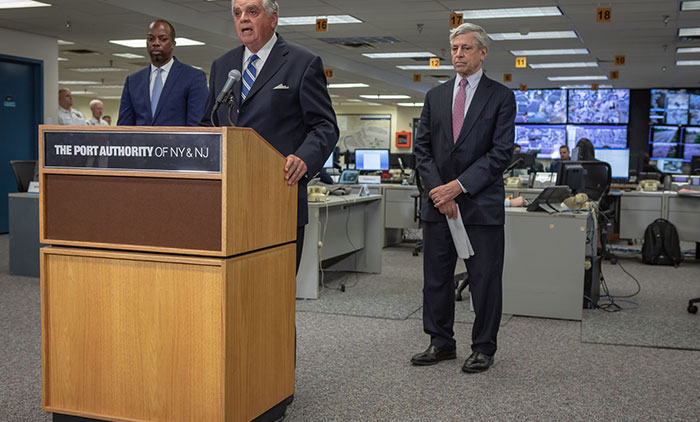Photos Courtesy of Port Authority and Forum Files
Former U.S. Transportation Secretary Ray LaHood on Thursday discussed his independent findings and recommendations regarding the events at JFK Airport during and following Winter Storm Grayson in January.
By Michael V. Cusenza
Inadequate leadership, lack of coordination, and deficiencies in communication at critical points during a January storm and the following days combined to turn John F. Kennedy International Airport into a cauldron of chaos that bubbled over with thousands of stranded passengers, flights, and bags, according to a report released on Thursday.
The 59-page analysis, “John F. Kennedy International Airport Operations during Winter Storm Grayson: Findings and Recommendations,” was drafted by a team from the law firm DLA Piper LLP and led by former U.S. Transportation Secretary Ray LaHood, at the request of the Port Authority of New York and New Jersey, which operates the airport.
Investigators sought out reasons for the meltdown and provided 50 suggestions “to assist JFK perform better for the flying public not just during weather events. They will help JFK operate more efficiently on a day to day basis, which is good for everyone who travels here,” LaHood said on Thursday as he delivered remarks regarding the report at the JFK Emergency Operations Center.
The dominoes began to tumble on Thursday, Jan. 4, with a winter storm that, according to the National Weather Service, brought “blizzard criteria” to the airport for several hours, including relentless snowfall and punishing winds that exceeded 60 miles per hour at times. The conditions caused widespread delays in arrivals and departures.
Friday and Saturday saw North Dakota-like temperatures visit the Northeast, with wind chill real-feel in the negative teens. This deeply affected systems and operations at the airport, exacerbating delays.
The cherry on the catastrophe sundae arrived that Sunday. At approximately 2 p.m., a water pipe that feeds the sprinkler system broke in the privately operated Terminal 4. After water from the broken pipe began flooding the terminal, power to the affected areas of the terminal was shut off for safety reasons.
LaHood said that he and his team found that the lack of coordination and communication at JFK “exacerbated already difficult conditions” presented by the powerful storm. However, LaHood emphasized that effort was in abundance.
“We found that when faced with the difficult conditions of Grayson, JFK management and other stakeholders pitched in to help each other. They tried, as best they could, to mitigate the poor conditions. Some worked 24 hours a day for days. People literally rolled up their sleeves and unloaded bags, carried passengers off planes, moved cots, and mopped up water—they did whatever they could to help—whether or not it was their job,” the secretary wrote. “Their effort did not end when the storm did. In the weeks and months after Grayson, JFK stakeholders participated in after-action debriefings and attended working group meetings. They met with me and my team and tirelessly provided witnesses, documents, and information. One thing was made clear—all had a desire to change JFK for the better.”
LaHood called the thousands of pieces of luggage stranded at JFK “another great source of frustration.”
“This cannot be permitted to happen again,” he said before noting that “a number” of the 50 recommendations in the report aim to fix the baggage problem.
Chief among LaHood’s recommendations is to enhance the functions of the JFK Emergency Operations Center that was activated in the days immediately following Grayson.
“Many of our specific recommendations build upon the EOC, which has been activated during the many additional weather events that occurred since Grayson,” LaHood said. “We saw the EOC in action, and it is an impressive operation. It is our goal that by adding to this already powerful mechanism, we can build a true command and control center for JFK.”
Overall, LaHood said he sees a bright future for the airport, its customers, and employees.
“With a strong leadership structure, effective communication, and coordination among various stakeholders, the unique structure of JFK— including its independently operated terminals—can be a strength, rather than a weakness,” he added. “We look forward to watching the progress unfold.”

